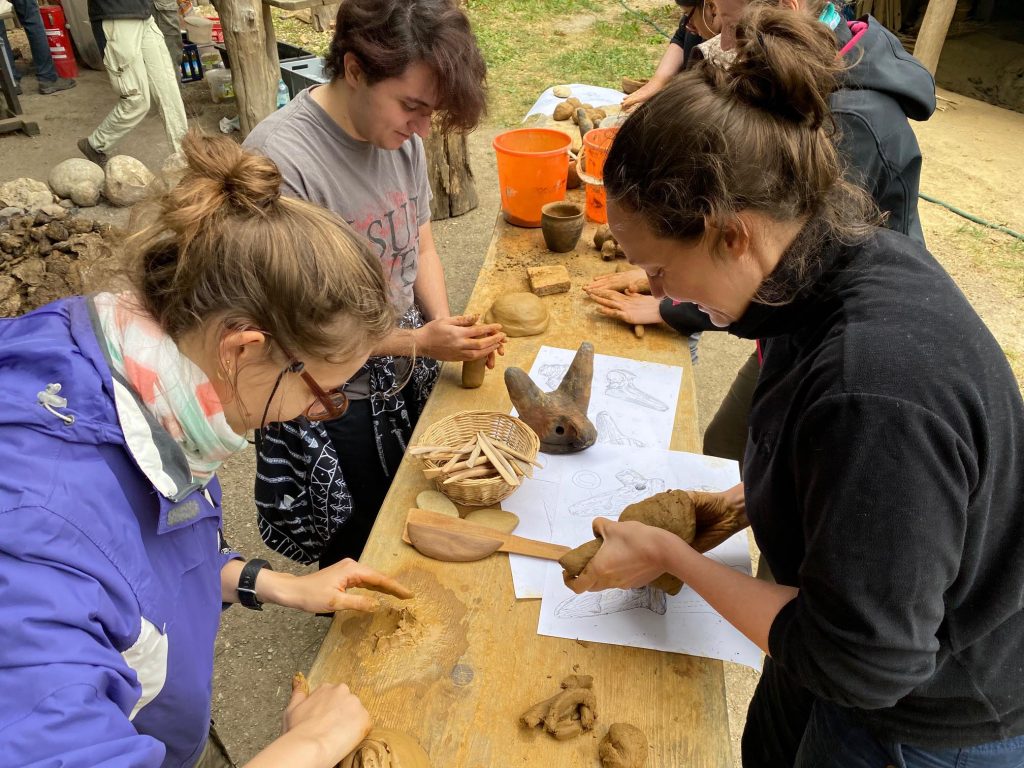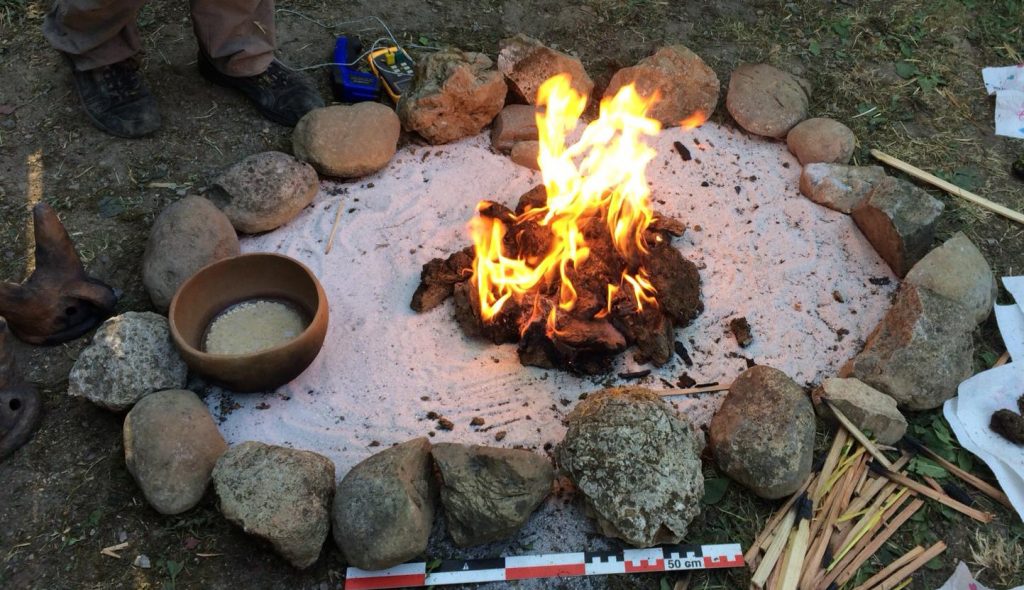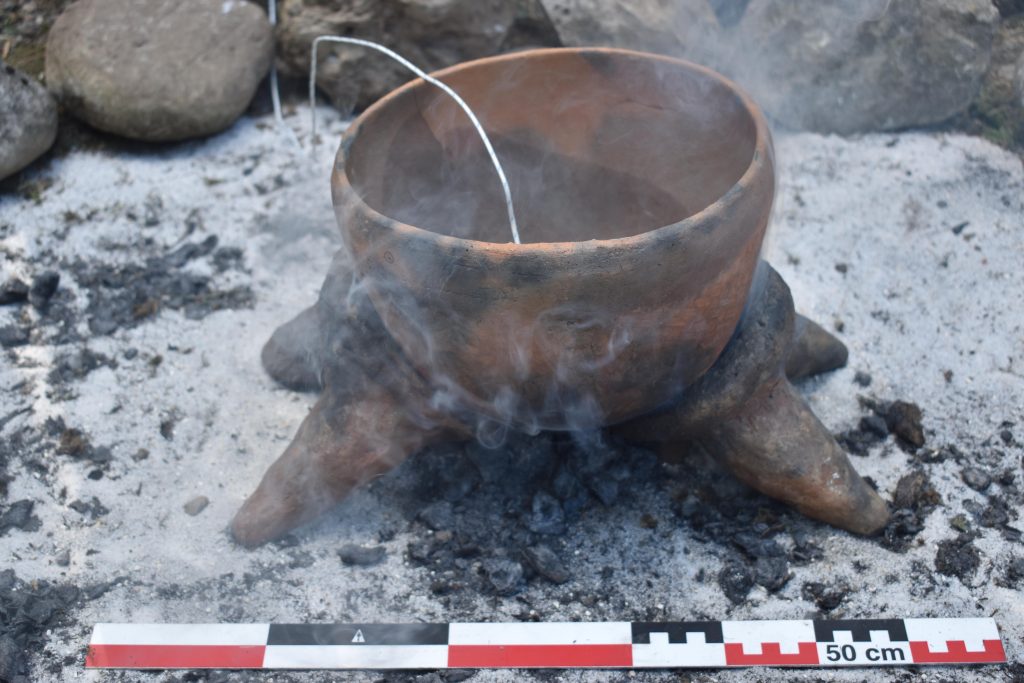As the new student assistant of the DiverseNile Project, I am happy to give in my first blog post an overview and summary about the experimental archaeology days at the MAMUZ Museum in Asparn/Zaya and of course about our experiments with the fire dogs, dung fires and pottery making.
Over the course of four days many archaeologists, experts and students came together in Asparn to work on several different experiments, share ideas, discuss questions and, of course, creating the possibility to experience archaeology in a practical and exciting way. Being outside in the nature, doing practical tasks and having a slight glimpse into how life was in the past was especially refreshing for everyone who had (and still has) to sit daily in front of a computer screen to follow online lectures.
I’ll start with a short summary about the event itself before I’ll describe our experiments.
In the big garden that belongs to the MAMUZ Museum, which is worth a visit and currently showcases an exhibition about experimental archaeology, are several reconstructed buildings and structures that showcase the history of humans in that area. Starting from tents of the palaeolithic times and ending at the current experimental construction of a medieval church. Inside and next to these buildings all different kinds of experiments were conducted, and certain techniques showcased, all part of a class of the University of Vienna where we could participate as guests from Munich. Experts showed how stones were chipped during the Stone Age and what materials were used for that, another explained how bones and horns were carved into tools and accessories, pottery was being made, as well as weaving, cooking a pig for a whole day in a pit and Ritschert (a stew the people who worked inside the Hallstatt mine ate everyday), iron and bronze smelting, creating jewellery and much more. One experiment I found extremely fascinating was the cremation of a pig on a pyre to figure out more about human burials of the European Bronze Age. The pig (which died naturally of an old age and not explicitly for this experiment!) was even dressed up and got ritual offerings for its descend into the fire and therefore afterlife, whatever that might have looked like for the people of the Bronze Age. Watching this, I can really imagine how special and touching such a burial practice was for these people, watching a loved one being consumed by the flames over several hours in such a way seems bizarre from our current, modern perspective of life and death.
Recapitulating I can really recommend the experimental archaeology days in Asparn. It was an incredible insight into life with its problems in the past and amazing that everyone showed you their skills and techniques while letting you try them out as well.
Now to our experiments: first we focused to let every participant get a feeling for the material clay while recreating Nubian figurines depicting female idols and animals. After everyone had fun creating figurines and got familiar with the material, we went one step back and created our own usable clay. Therefore, we learned what processes were necessary to get a formable material out of dry earth clumps. One part of our group was busy preparing the dry dung, in this case goat and horse dung, so it can be used to temper the clay. With that we created two types of different clay, one with the horse dung and the other with the goat dung.
The next task was important: recreating new fire dogs (based on the original drawings of the fire dogs from Sai Island and existing replicas made years ago within the AcrossBorders project) with the two different clay types which can be used for upcoming experiments. For all of us, who didn’t use pottery since elementary school, this was quite the big challenge to create them in the right proportions and dealing with the problems if parts breaking off or how to close cracks again. But in my opinion, everyone did a great job and we now have plenty of fire dogs that will hopefully survive a lot of future experiments!

While our figurines, fire dogs and test vessels were drying to be ready for burning, we started to figure out how the different dung types we had available behaved when trying to make a fire out of them. For our first small experiments that way, we split up in two groups where each group had to use camel and horse dung and, in the end, compare the results. For our first attempts the results were not really convincing: in both groups it took us a long time to start a fire with the camel dung, it produced a lot of (not so pleasant) smoke, the flames didn’t last long only with constant blowing into the fire, but when it worked we reached around 500°C. The horse dung was a little bit better, but it was still hard to get to a flame. The two experiments got inconclusive results with the highest temperatures varying in between 300°C and 660°C.
Though there are many reasons why our fires didn’t work the way we hoped, first we had to figure out how we organise the experiments on our own and with try and error we found better ways to observe our fires for the next tasks. Also, the quantity of the dung we used had a big impact on how the fires behaved, small amounts burned down way to quickly, and the windy weather wasn’t great for the flames either. But when experiments don’t work out the way you anticipate you learn a lot more and can change parameters for the coming ones.
Meanwhile, our PI Julia Budka conducted, together with a group of colleagues, the firing of pottery using cow dung as fuel. Surprisingly that fire reached over 1000°C, an incredible heat for such a simple fire. Whereas we found that exciting, the pottery didn’t, and a few were damaged in that heat. But this surprising result needed a follow up experiment, checking whether these high temperatures can be replicated.
Therefore we created two small fires, like in our previous experiments, with two different cow dungs to see which temperatures we could reach. We quickly realized that small fires didn’t reach those high temperatures and were only around 500°C and behaved like horse and camel dung previously. Therefore, we decided to create a bigger fire, which worked surprisingly better! We quickly reached the same temperatures in the small experiment and surpassed them in a short amount of time. While blowing into the fire with three persons in a row, we successfully reached over 1000°C in a few minutes and this in a smaller fire, compared to the one where the pottery was burned. This opens a possibility for different future experiments!

As our last experiments we used two firedogs and one cooking pot to figure out if such a setup is useful for cooking. We started a fire with horse dung in the middle between the two firedogs, above it we placed the pot, so it sat on the two firedogs. For a while it worked pretty well, but as the dung created more and more ash the space was not big enough that the fire could get enough oxygen to burn and be sustained with new dung properly. It was a long and tedious process to cook something this way. Also, the term cooking is misleading, we just barely managed to heat the water inside the pot a little bit.

Since this experiment didn’t work well, we decided to change our methods and tried a big fire with cow dung again. We spread out the dung on a bigger area, created a well working fire and placed the firedogs and the pot in the centre of it. The fire was burning and reached a temperature of around 470°C, but surprisingly the contents in our pot only measured around 60°C. Where did all the heat go? Was the pot absorbing all the heat or the firedogs? In the end the firedogs suffered quite a bit in this fire, they ended up turning completely black – nothing which is known from the real archaeological findings.
With that our experiments in Asparn ended with a lot more questions and we still have no definitive answer how the firedogs were used exactly. Let’s hope we can continue our experiments next year with the new knowledge and questions we gained this time!
